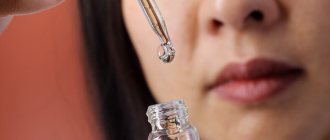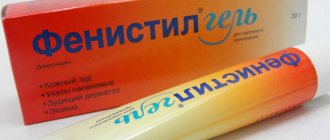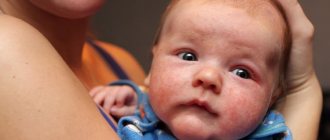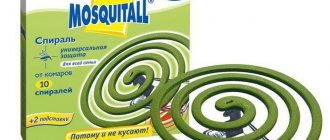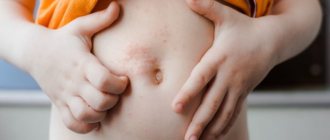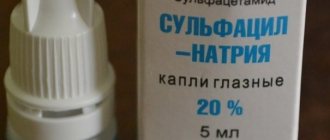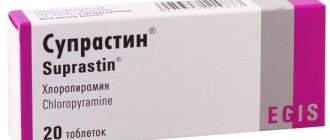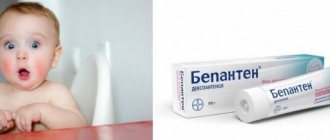Allergy drops for children are more difficult to find than medications for treating adults. Weak immunity, imperfections of the gastrointestinal tract, high sensitivity to drug components are factors that complicate the use of antihistamines in the treatment of allergic diseases in children.
Which drops are suitable for children under one year of age? What effective, safe medications do doctors recommend for children 12 months and older? What are the features of using antiallergic drugs in childhood? The answers are in the article.
Drops for eyes and nose for allergies
In some cases, it is impossible to do without local medications.
They are ideal for the treatment of rhinitis and conjunctivitis. For children over one year of age, vasoconstrictor drops and antihistamines can be used. Allergic rhinitis can be quickly and effectively eliminated using the following medications:
- Vibrocil drops contain dimethindene and a special adrenergic substance. With its help, it is possible to quickly and effectively eliminate swelling and exudation. The drug is completely safe, so it can be used from the first month of the baby’s life.
- Prevalin contains bentonite, which helps get rid of swelling in a short time. With its help, it is possible to eliminate allergens and other harmful microorganisms.
- If allergic rhinitis manifests itself in a mild form, then it is allowed to use a solution of table salt and water. In the pharmacy you can find a ready-made drug - Aquamaris. With its help, it is possible to mechanically remove allergens and microbes from the nasal cavity. The drug is recommended for use as an effective prophylactic against hay fever.
- Drops with alpha and adrenergic agonists help to get rid of swelling and exudation within a short period. The positive effect is achieved due to the rapid narrowing of blood vessels. Such drops can be used for no more than seven days. Otherwise, addiction occurs in the body. Drops are allowed for children from two years of age.
- Derinat - unique drops. With their help, it is possible to improve immunity at the local level. The positive effect can be felt only on the fourth day of active use.
To treat allergies in infants, it is most convenient to use drops.
Compositions for the eyes and nose often include fatty stabilizers. However, they do not have a negative effect on the body, so they can be used if the child is already one month old.
Allergies in children can be aggravated by conjunctivitis. In this case, you should use special eye drops:
- Ophthalmol contains fast-acting antihistamines. To achieve maximum effect, boric acid and zinc sulfate are also added, which help get rid of signs of secondary infection.
- Prevalin.
- Cromoglin has a mechanical effect on mast cells. Thanks to this, they stop producing histamine. The manufacturer also produces the active substance in the form of a spray. It can be used to treat children from two years of age.
- Tobrex contains antibiotics, so it is recommended to use it in case of secondary infection. It can begin its active spread in the conjunctival sac. In this case, the baby constantly touches the eye and tries to scratch it.
Any medication may be used only after consultation with a pediatrician or allergist. In this case, contraindications and side effects must be taken into account. You should select medications very carefully in case of hypersensitivity to individual components.
Allergies are very dangerous for newborns. If the pediatrician has made the appropriate diagnosis, then parents must strictly follow his recommendations. Individual intolerance in a baby manifests itself in different ways. If the mother notices a negative change in the condition of the baby’s skin or behavior, she should immediately seek help from an allergist. He will be able to take appropriate samples and choose the right diet to prevent the situation from getting worse. When treating allergies, the first priority is to prevent a negative reaction.
Products by age
If allergic symptoms occur in a newborn baby, they are often less dangerous than the effects of drugs on the body.
If symptoms are severe in infants aged one month, you should call an ambulance. There is no need to run to the nearest pharmacy and buy goods.
Up to a year
https://youtube.com/watch?v=0uN6FgMoI2E
Let's see what drops in the nose or eyes can be prescribed for children from birth to 1 year for allergies:
Zodak. Allowed from two months of age. They are usually dissolved in water or infant formula.
Fenistil. Prescribed by doctors for newborns from 1 month, usually once a day.
Zyrtec. Allowed for use from six months. Dissolves in artificial mixture or water.
Suprastin. Can be found in the form of injections and tablets. Appointed from one month
This drug should be used with extreme caution as it is addictive.
If allergies are detected in infants, the mother's diet should be adjusted. If the baby is bottle-fed, then it is necessary to select a high-quality hypoallergenic formula.
Antiallergic drugs in the form of drops for signs of allergies should be given to infants under one year of age strictly as prescribed by the pediatrician.
From one to three years
Drops prescribed for children from 1 year to 3 years:
- Zodak is an oral medication that is prescribed for seasonal exacerbations of allergies and conjunctivitis.
- Nasonex - nasal drops. It can be used to treat children from two years of age, but only after a doctor’s prescription, since the drug is hormonal.
- Cromosol is used for inflammation of the eye mucous membranes and conjunctivitis.
- Vibrocil is a nasal remedy. Quite quickly eliminates swelling of the mucous membranes.
- Ifiral - antihistamine drops that are used for rhinitis.
From 3 years
Eye and nasal drops intended for children over 3 years of age:
- Zyrtec in the form of drops. They are usually used to eliminate allergic reactions in the body for children from six years of age.
- Cromohexal is used when exposed to seasonal irritants. It is not addictive and can be used for quite a long time.
- Lecrolin is an ophthalmic agent. Belongs to a group of antihistamines that can only be taken after four years of age. Can be used as an allergy prevention.
Alternative drugs
Antihistamines belonging to the first and second generation are rarely prescribed to children, because These drugs are more likely to cause side effects. However, such medications help to quickly eliminate the manifestations of an allergic reaction. Alternative drugs in the form of syrups are recommended for short courses.
Suprastin
Suprastin can be used to treat patients older than 1 month. It is only available in tablet form. They can be crushed into a powder and added to breast milk or formula. This remedy quickly eliminates allergy symptoms, but causes severe drowsiness even when used in small doses. The drug is prohibited for use in the treatment of children suffering from lactose deficiency.
Fenistil
Fenistil can be used to treat babies older than 1 month. The dose is selected individually, taking into account the child’s weight. Fenistil should be taken 2-3 times a day. Possible adverse reactions in children under one year of age include tachycardia, nervous system excitement and urinary retention.
Alerzin
The drug is available in the form of drops. It is intended for infants over 6 months. More often it is prescribed for the treatment of urticaria and seasonal rhinitis. In addition, it can be used to prevent allergies.
Zyrtec
Zyrtec comes in the form of drops. It can be mixed with breast milk and formulas. The drug is recommended for use in children over 6 months of age. The use of the drug is justified in the treatment of urticaria, hay fever, allergic rhinitis, etc. The drug is given to the child 2 times a day.
Rolinosis
Rolinoz is a drug whose main active ingredient is cetirizine. The product can be used to treat children from 2 years of age. The daily dose is selected taking into account the weight and age of the patient. It is divided into 2 doses.
Diphenhydramine
Diphenhydramine is prescribed only for severe allergic reactions that threaten the child’s life. The drug is prescribed for children over 1 year of age. It allows you to quickly eliminate allergy symptoms.
What form of medication is best for a child?
Each dosage form has its own advantages and disadvantages. It is possible to combine local (external) agents in the form of gels and ointments with tablets for oral administration.
Pills
Have the following advantages:
- easy to use;
- act quickly;
- well absorbed in the gastrointestinal tract;
- have a systemic effect (absorbed into the general bloodstream and distributed throughout the body);
- convenient to store.
Syrups
They have a pleasant (sweet) taste. They often cause allergic reactions in hypersensitive children due to the presence of auxiliary components (flavors, fragrances).
Ointments
Effective for skin allergy symptoms - rash, redness, itching. Ointments have a healing effect and can be prescribed for burns and insect bites. They are suitable for children 5 years and younger. The disadvantages are the lack of systemic action (ointments and gels are ineffective for rhinitis, Quincke's edema, shock, conjunctivitis, hay fever) and the need for repeated application to the skin.
List of funds for older children
After a year, young patients also receive drugs in liquid form. When developing a treatment regimen, the doctor takes into account the child’s age and weight, the strength of the allergic reaction, and the type and form of the disease.
- the modern drug is prescribed to babies and older children, the minimum age is 12 months;
- the dropper bottle contains 10 or 20 ml of medicinal solution;
- the product contains cetirizine dihydrochloride, which actively relieves allergy symptoms;
- composition with active antipruritic, antiexudative, antiallergic effects;
- some children feel the effect within a third of an hour; in the majority of young patients, negative symptoms weaken after 50–60 minutes;
- prolonged action throughout the day. Even after discontinuation of the medication, the positive effect on the body appears for another 72 hours;
- Cetirizine is prescribed to children for dermatitis, rhinitis, allergic conjunctivitis, hay fever, urticaria, including giant urticaria. The drug reduces the severity of attacks in bronchial asthma;
- if the instructions are followed exactly, undesirable signs rarely appear in children;
- The duration of use and dosage depend on the body weight and age of the child.
Suprastinex
- a remedy for relieving symptoms of chronic and acute diseases against the background of increased sensitivity of the body;
- the drug is prescribed to children from 2 years of age;
- The active component of antiallergic drops is levocetirizine dihydrochloride. The active substance is more actively absorbed by the body, unlike cetirizine, and does not require additional transformations;
- Suprastinex drops are effective in the treatment of urticaria, hay fever, allergic dermatoses, Quincke's edema;
- after taking the drops, the histamine-dependent stage of allergy is blocked, the release of inflammatory mediators stops, and the degree of negative reactions decreases;
- the minimum concentration of levocetirizine reduces the risk of side effects;
- in case of severe renal failure, congenital lactose intolerance, hypersensitivity to levocetirizine, Suprastinex is not prescribed;
- 5 drops of the drug are enough for one dose; the composition is given twice a day;
- negative symptoms subside within 15–20 minutes.
Rules for nutrition and diet for food allergies in adults are described on this page.
Sources
- https://allergiya-med.ru/simptomyi/allergiya-u-detey-simptomyi-reaktsiya-proyavlenie/
- https://medvestnik.ru/content/news/v_nizhnem_novgorode_proshla_nauchnoprakticheskaya_konferenciya_evolyuciya_vzglyadov_na_allergologiyu.html
- https://ru.wikipedia.org/wiki/Allergen
- https://ru.wikipedia.org/wiki/Hay fever
- https://www.katrenstyle.ru/articles/journal/goods_sales/vesennyaya_allergiya_4_klassa_preparatov
- https://plannt.ru/glaznye-kapli-ot-allergii
- https://allergiinet.com/lechenie/preparaty/kapli-dlya-detej.html#h2_11
Effective drugs for children under one year of age
For the youngest patients, pharmaceutical companies offer few oral antihistamines. It is forbidden to give the baby medicine for older children: the components can adversely affect organs and systems. The drops are diluted with a small amount of breast milk or boiled water.
- proven allergy remedy;
- active substance – dimentindene maleate;
- allergy medicine for the youngest patients: pediatricians prescribe most formulations only from six months;
- the drug relieves negative signs within a quarter of an hour, in most children the signs weaken after 40 minutes;
- drops are prescribed from 1 month; according to indications, the composition is approved for newborns;
- Fenistil drops are prescribed for many diseases of an allergic nature, including dermatitis, Quincke's edema, drug and food allergies. The drug helps with intoxication after insect bites;
- Duration of therapy is up to 7 days. If the effectiveness of the medicine is low, a more detailed examination of the baby will be required.
- Zodak oral allergy drops are prescribed after two weeks of age;
- the bottle contains 20 ml of antiallergic agent;
- Cetirizine dihydrochloride is the active substance of an antihistamine;
- a medicine with a prolonged action effectively relieves signs of urticaria, allergic conjunctivitis, and rhinitis (year-round and seasonal) in children;
- children tolerate the effect of the drug well, negative reactions rarely occur;
- The dosage depends on the age of the child.
- an effective antiallergic drug of a new generation;
- minimal risk of adverse reactions;
- the drug contains cetirizine dihydrochloride;
- prescribed to babies from 6 months;
- with prolonged use, the addictive effect does not develop;
- the dosage depends on the weight and age of the child;
- sometimes Zyrtec drops cause drowsiness;
- a safe remedy for the treatment of many diseases of allergic origin.
Review of antiallergic drops for babies up to one year old
Fenistil
The drug contains dimethindene. Refers to antihistamine drugs of the first (oldest) generation. However, it has not lost its relevance today. It is often prescribed by pediatricians and allergists.
Advantages of the drug:
- can be used in the treatment of children over 1 month of age;
- does not contain alcohol or dyes;
- easy to dose (the bottle has a dropper - a special dosing device, and calculating the amount of the drug for a specific small patient is simple - 2 drops per 1 kg of weight);
- can be added to a bottle with warm food, given from a spoon;
- non-hormonal agent;
- suitable for the whole family (indicated for both children and adults);
- sold without a prescription;
- available in all pharmacies, as it is in demand, which means it will be easy to find.
Fenistil copes well with allergic manifestations on the skin, hay fever, alleviates the condition of children with chickenpox, when the skin in the area of the rash is very itchy and irritates the child, and can be used for insect bites.
Disadvantages of Fenistil:
causes drowsiness, lethargy, decreased ability to concentrate; after its use, the development of tachyphylaxis is possible - a decrease in the therapeutic effect after repeated administration; causes dryness of the mucous membranes of the nose, throat, and mouth; It’s not cheap – more than 400 rubles. per bottle of 20 ml. The drug is produced in Switzerland
The same manufacturer supplies the Russian pharmaceutical market with such well-known drugs as Vibrocil, Otrivin and other drugs. The company positions Fenistil as an over-the-counter remedy for the treatment of allergic skin problems
The drug is produced in Switzerland. The same manufacturer supplies the Russian pharmaceutical market with such well-known drugs as Vibrocil, Otrivin and other drugs. The company positions Fenistil as an over-the-counter remedy for the treatment of allergic skin problems.
Zyrtec
The active ingredient is cetirizine (second generation antihistamine). Zirtec is an original drug, that is, the manufacturing company was the first to synthesize and patent a drug with this composition. This is her “child” whom she “gave birth to” and knows “inside and out.” This is evidenced by numerous clinical studies (placebo-controlled, in particular).
What can be said in favor of Zyrtec:
- can be used in young children (from 6 months) and adults;
- does not contain dyes or flavors, which means it will not cause additional allergic reactions;
- relieves symptoms throughout the day (apply 1-2 times a day);
- onset of action – after 20 minutes;
- has a good reputation among pediatricians and allergists (in 2017 the drug became the most prescribed);
- It is classified as over-the-counter, which means it has a high safety profile.
Zyrtec is indicated for children with allergic rhinitis, inflammation of the conjunctiva, and urticaria. These are the symptoms of the disease that the drug copes with best.
Zyrtec also has disadvantages:
- cannot be used in children under 6 months of age;
- limited range of indications for use (does not help in all cases of allergies);
- price - more than 300 rubles. per bottle 20 ml.
Produced by an Italian company. It also produces such well-known drugs as Nootropil, Xyzal, Keppra, etc. The company positions its drug as an effective new generation antiallergic drug for the treatment of children and adults suffering from lacrimation, redness of the connective membrane of the eye, sneezing, congestion and runny nose. , itching.
Zodak
The active component of the drug is the same as that of Zyrtec. Only Zodak is not an original drug, but a generic. The manufacturer took a ready-made medicinal formula as a basis and, based on previous research, released its product under a different name.
The advantage of the drug over Zyrtec is only in price. Zodak costs about 100 rubles. less. It has the same disadvantages as Zyrtec.
Zodak is produced by factories in Germany and the Czech Republic. Patients recognize the manufacturer of the drug by the name of such brands as Lozap Plus, Finalgon, Rosucard, etc.
Allergy drops for newborns
Nowadays, allergies and reactions to various substances most often affect the body of newborn children. Due to severe sensitivity, a weak immune system and possible congenital diseases, it is very difficult to choose allergy drops for children.
Article on the topic: Diet for allergies in children: menu from an early age
Some drug companies, taking into account the severity of allergies in children, create special drops.
The list of the most popular is given below:
- Zodak. Prescribed for the youngest children, infants from two weeks. The drops contain up to 20 ml. active substance. A strong antihistamine that needs to be instilled into the nose twice a day. This medicine perfectly relieves redness, itching, possible swelling, and also speeds up the healing process for seasonal or infectious conjunctivitis. Experienced experts say that the substance can relieve symptoms and speed up the recovery of children by up to 3-4 days.
- Fenestyl. The main substance is dimentindene maleate, which can eliminate even severe allergy symptoms. The best anti-allergenic product that doctors recommend for children from one month old. For food allergies, angioedema, and dermatitis, drops can relieve symptoms in infants in a few hours. Pediatricians usually prescribe therapy lasting 7 days.
- Zyrtec. Antiallergic drops, which pediatricians recommend for children aged 6 months and older. There are several positive qualities: quick effect, non-addictive, does not cause negative reactions, treats all types of allergic reactions.
It is very important to choose a medicine against allergies for children under one year old in order to speed up the healing process from a very early age, and it is possible to completely cure children from various allergic reactions. In addition to medications for newborns, doctors for long-term treatment recommend some medications for children under one year of age
They are usually prescribed from 6-8 months, the course lasts from 4 to 6 weeks. After which, the pediatrician should examine the child for possible further treatment.
In addition to medications for newborns, doctors for long-term treatment recommend some medications for children under one year of age. They are usually prescribed from 6-8 months, the course lasts from 4 to 6 weeks. After which, the pediatrician should examine the child for possible further treatment.
Food allergy medications for children
Medicines for food allergies in children are used in a complex manner. After stopping an allergic attack with broad-spectrum antihistamines, young patients are also prescribed medications from the following groups:
- Enterosorbents (Enterosgel, Atoxil, Smecta). They will help quickly remove allergens and their metabolites from the body.
- Probiotics (Hilak forte, Linux). Often food allergies are associated with a violation of the microflora of the digestive tract, so it is necessary to eliminate dysbiosis.
- Hepatoprotectors (Galstena, Karsil). If a small patient suffers from food allergies, this may indicate pathologies in the hepatobiliary region, so the baby may be prescribed medications to support the liver.
In addition, if food allergies occur, children are advised to drink plenty of fluids and switch to a hypoallergenic diet.
Allergy medications for newborns: name, active ingredient, price
Allergies in newborns occur mainly to food, household chemicals and cosmetics. Only as a last resort should you give your child medications. The baby’s immunity is just developing, and medications can cause irreparable harm to his body. In addition, many of them have side effects (impaired liver and kidney function).
Allergy remedies for newborns up to 1 month
Allergies in children under 1 month of age are not considered dangerous. More dangerous can be medications, which often block the natural production of substances in the child’s body that are responsible for effectively fighting infections and diseases.
Effective allergy remedies for newborns are as follows:
removing from the mother’s diet (if the baby is breastfed) all foods that can cause allergies;
breastfeed the baby for as long as possible, combining this with the mother’s constant diet;
- if the baby is artificial, then you need to choose a suitable mixture for him, preferably hypoallergenic and sugar-free (the choice is now very large);
- do not introduce complementary foods before 6 months for infants (before 4 months for artificial babies);
- do not introduce chocolate, citrus fruits, strawberries, kiwi, tomatoes, pineapples until one and a half years;
- to relieve allergy symptoms, you can use a decoction of chamomile or string (add to the bath when bathing along with sea salt);
- It is recommended to do wet cleaning every day in the house where the baby lives.
If a child of 1 month of age has a severe allergic reaction (swelling, difficulty breathing, etc.), there is no need to self-medicate. You must call an ambulance immediately.
Allergy remedies for newborns (list)
All allergy medications used to treat children are not self-prescribed. It is necessary to consult with a therapist and undergo a series of tests from an allergist and immunologist. Antihistamines have contraindications and a number of side effects. For children, allergy medications are available in drops, gels and creams.
Effective allergy remedies for newborns are described in the table below.
Name of the drug, price Action Features “Zodak”, drops for oral administration, from 138 rubles Dissolve 4-5 drops in milk formula or water. The course of therapy lasts 5-10 days. Approved for use by newborns from 2 weeks of age. Side effects: abnormal stool, severe fatigue, runny nose, drowsiness. "Fenistil", drops for oral administration or gel for external use, from 320 rubles Dissolve 10-30 drops in milk mixture or water
Take 1 time per day during or after meals. Use the product in the form of a gel to lubricate the external manifestations of allergies, but without affecting too large areas of the skin. Approved for use from 1 month. Side effects: dry mouth, dizziness, nausea. Not addictive. “Zyrtec”, drops for oral administration, from 300 rubles Dissolve 5 drops in milk formula or water Take 1 time per day during or after meals. Approved for use from 6 months. It is prohibited for people with kidney diseases. Side effects: dizziness, severe fatigue, headache, problems with bowel movements and urination. Not addictive. “Suprastin”, liquid for injection and tablets, from 121 rubles Take ¼ tablet per day, grinding it and adding to the mixture or water. Use for no more than 10 days and only as prescribed by a doctor (important). It is better not to use for up to 6 months. Approved for use from 1 month. Addictive. Side effects: drowsiness, dizziness, lethargy, insomnia, nausea, vomiting, abdominal pain. “Elidel”, ointment, from 916 rubles. Used to treat allergies on the skin. Apply to damaged areas 2 times a day. Use for up to 3 weeks. Approved for use from 3 months. Use with caution and only as a last resort (important). “Bepanten”, cream, from 379 rubles. Used to treat any negative manifestations on the skin, including allergies. Apply 1-2 times a day to dry, cleansed skin. Approved for use from the first days of life. May cause itching.
Although the modern market offers a wide variety of antihistamines, they should be used with caution and only with the approval of a doctor. The baby should not be given medications until one month of age.
The only exception is Bepanten cream.
Contraindications, side effects, overdose
The main contraindication for all medications, not only anti-allergenic ones, is individual intolerance to the constituent substances. As a rule, such medications have the following side effects:
- First-generation drugs most often cause drowsiness, lethargy, and fatigue;
- Dry mucous membrane;
- Nausea, vomiting;
- Loss of appetite;
- Difficulty urinating;
- Allergic reaction (rash) to the substances included in the composition.
Another undesirable effect of use may be addiction. Therefore, before giving the medication to an infant, you should carefully read the composition and strictly follow the instructions.
Do not exceed the indicated dosage or give the drug to your baby at the wrong time. Medicines are usually taken after meals.
The article discussed what can be given to a baby for allergies. The list of medications presented is incomplete, since there are many options for medications. However, young parents should remember the basic rule - no medications should be given before the baby is examined by a doctor. The specialist will tell you which drug is most suitable in a particular case.
How allergy medications work
Treatment of the disease includes the use of drugs from the following groups.
- Antihistamines. They are used most often, especially in children. Such drugs block the receptors with which histamine, a natural substance in the body, must contact, provoking the development of edema, spasm of the bronchial muscles, dilation of capillaries, etc. in response to the action of a substance recognized as dangerous. Antihistamines trick the brain into taking the place of this neurotransmitter. As a result, it cannot contact the receptor and an allergic reaction does not occur.
- Mast cell membrane stabilizers. It is from the latter that histamine is released in order to then contact H1 receptors. Mast cell membrane stabilizers work precisely at this stage - they do not allow the neurotransmitter to leave its refuge. More often used for preventive purposes.
- Glucocorticosteroids. Hormonal drugs that relieve swelling, inflammation, eliminate shock and provide other beneficial effects for allergies.
- Vasoconstrictors. They are also called decongestants. They act in the same way as adrenaline and norepinephrine - they bind to alpha-adrenergic receptors, as a result of which the vessels in the nose, throat, and sinuses narrow, blood flow decreases, swelling decreases, and breathing is restored. Relevant for the treatment of local allergy symptoms, especially rhinitis.
- Saline solutions. According to the law of osmosis, a solution with a higher concentration passes into a solution with a lower concentration. So, saline solutions remove swelling and reduce the amount of nasal discharge, cleanse the mucous membrane of secretions and allergens.
Drugs of other groups are used less frequently, especially in children. Sometimes allergists and pediatricians prescribe calcium gluconate in tablets (taking into account the patient’s age) or intravenous injections for acute conditions. However, the mechanism of the antiallergic effect of the drug is still unknown.
Folk remedies
Treatment of allergies using traditional methods must begin with minimal doses, since it is possible to develop a reaction to the remedy itself.
Before using decoctions, oils and lotions from medicinal herbs, it is necessary to test for reaction. A small amount of the product should be applied to a healthy area of the child’s skin and wait a little. If allergy symptoms do not appear, then this treatment method is suitable for the baby.
Series
After the umbilical wound has healed, you can make baths from this medicinal plant. This procedure cleanses the baby’s skin, soothes and has a positive effect on the functioning of the nervous system. To prepare an infusion for bathing, you need:
- Pour 5 g of herb into 3 cups of boiling water;
- leave for 12 hours, wrapped in a blanket;
- strain and add to the bath.
One such procedure per week is enough. Bathing duration is 10–15 minutes.
You can also make an ointment from this plant. For this:
- keep petroleum jelly and lanolin (25 g each) in a water bath for 10 minutes (separately);
- 2 tsp. add the pharmacy tincture of the string to the heated lanolin, mix;
- Add Vaseline to the resulting product.
The ointment is used to lubricate the affected areas several times a day.
Bay leaf
Can be used to treat allergies from a very early age. Bay oil effectively relieves inflammation, eliminates itching and swelling. To prepare it, you need:
- Pour 30 g of dry crushed leaf with 1 glass of linseed oil;
- place in a dark glass container;
- leave for 7 days in a cool place.
This product is used not only to lubricate the skin, but also for instillation into the nasal passages of a child with allergic rhinitis.
You can get rid of extensive rashes using baths with bay decoction, which is prepared as follows:
- 100 g of bay leaf is brewed with one liter of water;
- leave for 30 minutes;
- without filtering, pour into bathing water.
Aloe juice
Lotions made from the juice of this plant help eliminate itching, relieve rashes, and moisturize the baby's skin.
Aloe juice can be mixed with potato or pumpkin juice in equal proportions. Soak a cotton pad in the resulting product and wipe the inflamed areas of the skin.
Herbal baths
- In the acute stage of the disease, it is useful to take baths with chamomile. To prepare the infusion you need:
- 2 tbsp. l. dry plant, pour 0.5 liters of boiling water;
- leave for half an hour;
- add to bathing water.
- Baths with oak bark decoction are also effective:
- Pour 100 g of oak bark into a liter of water;
- leave for 6 hours;
- simmer over low heat for half an hour;
- strain and pour into bathing water.
- It is useful to add a decoction of viburnum branches to the bath for infants. It is prepared as follows:
- Brew a handful of viburnum branches in a thermos with two liters of boiling water;
- leave for two hours;
- strain and add to bathing water. Take a bath every other day.
The effect of folk remedies for allergies is possible only with their regular use.
Folk remedies for treating allergies - gallery
In most children, allergy symptoms disappear with age. But this does not mean that the process can be left to chance. If you don’t help your baby now, the allergy may stay with him for life or develop into more serious illnesses.
Causes and symptoms of allergies in children
The interaction of immune system cells with foreign proteins leads to a negative reaction with the development of allergic inflammation. Pollen, foods, and medications that are safe for most people, if prone to atopy, cause negative symptoms in the oral cavity, digestive tract, skin, eyes, respiratory tract, and nasal passages.
In severe forms of the disease, internal organs suffer. A specific response of the body develops when the immune system malfunctions. When the body is highly sensitized, contact with an irritant sometimes causes symptoms that are life-threatening to the child.
- weak intestines and stomach;
- decreased immunity;
- congenital tendency to allergies;
- a pregnant woman consumed a lot of citrus fruits, full-fat milk, chocolate, honey, seafood, strawberries;
- the baby receives antibiotics;
- dysbacteriosis;
- helminthic infestations;
- a nursing mother violates the recommendations of a pediatrician and nutritionist and eats food that causes an acute allergic reaction in the baby;
- bad ecology;
- early complementary feeding, feeding the baby with low-quality, highly allergenic or age-inappropriate products;
- The baby receives artificial formula from the first days.
Effective methods for treating allergic dermatitis on the face in children and adults are described on this page.
The main signs of allergies in children:
- small allergic rash, blisters with liquid on the skin, blisters, weeping or peeling of the epidermis, ulcers, crusts on opened formations;
- skin redness;
- skin itching, mild or severe burning sensation;
- swelling of the face, hands, eyelids, lips, larynx, tongue;
- digestive disorders, colic, diarrhea, nausea, abdominal pain, vomiting;
- tearing of the eyes, swelling of the eyelids, hyperemia of the sclera;
- thin mucous discharge from the nose, rhinorrhea, sneezing;
- allergic cough (almost no sputum), shortness of breath, difficulty breathing.
How to help a child?
Allergies in a child are usually treated with antihistamines, which should be selected together with a doctor. These medications contain a substance that will block the production of histamine in the body upon contact with an allergen. In addition, it is important to eliminate contact with the irritant.
Otherwise, drug therapy will be ineffective.
Special diagnostics help to detect the allergen.
To do this, skin tests, provocative and elimination tests are carried out, and the blood is examined for the presence of specific antibodies.
Characteristics of the issue
Allergy therapy for a child under one year old involves taking various antihistamines and hormonal medications.
Histamine is a biologically active substance synthesized by the child’s body as a response of the body’s defense systems to the action of an irritant.
Allergic reactions can occur in a child with a weak immune system when the baby’s mucous membranes and skin are exposed to substances that act as allergens.
These may include some substances from food, medicines, pollen of certain plants, insect bites, odors of perfumes, components of household chemicals.
In this regard, allergists and immunologists distinguish three classes of antihistamines:
First generation drugs are used to treat allergies in children when urgent relief of symptoms of the disease is necessary.
However, given the specifics of these medications, they are eliminated by the body after a short period of time, and therefore, in order to continue the therapeutic effect, it is necessary to use medications of this group more often.
This can be attributed to the negative characteristics of drugs, since they can cause a negative effect when affecting the child’s nervous system, causing a decrease in activity and pathology in the functioning of the vestibular apparatus.
Medicines in this group include: Diphenhydramine, Suprastin, Alfadril, Promethazine, Tavegil, Diazolin, Fenkarol, Peritol, however, Tavegil can be used to a limited extent for the treatment of children. However, its use is also excluded when treating allergic manifestations in newborns.
Second generation drugs are characterized by high speed of action with long-term (days) fixation of the achieved effect.
These drugs are distinguished by relative safety when used and the absence of a hypnotic effect.
The regimen for taking them is not tied to periods of food intake and, according to experts, these medications are best used for allergies for a child under one year old.
Drugs in this group include medications such as Claritin, Kestin, Zyrtec, Loratidine, Cetirizine. The most popular of this group of drugs is Loratidine, because in addition to its high efficiency, it ensures the absence of side effects.
Third-generation drugs ensure the achievement of maximum effect when they remain in the body for a long time; they are used for the most part in regimens that provide for long-term treatment.
Among such drugs are Astemizole, Gismanal, Terfen and Terfenadine.
In addition to the three groups of antihistamines, corticosteroid-type medications may be used in therapeutic regimens, depending on the symptoms.
These products are highly effective when used to relieve inflammatory manifestations of allergies.
However, these drugs have a number of side effects that limit their use only to the elimination of severe forms of allergies.
Various types of sorbents are used as maintenance therapy to eliminate allergens from the body, including Polyphepan, Enterosgel, Smecta, Polysorb MP and activated carbon.
The specifics of allergy treatment for a child involve choosing the most effective medication while minimizing the consequences of using the drug.
In this regard, before prescribing the drug, the allergist and immunologist conduct a conversation with the parents to identify symptoms of the disease and, if necessary, prescribe additional tests.
More on the topic “Allergic rhinitis: treatment in children. List of allergy medications”:
Runny nose. How to treat? Children 1.5+
Dear mothers! Help!!!!! How to cure my daughter's runny nose. I can’t really listen to her grunting at night! What remedies help? We are 1.7
Allergic rhinitis: TIZIN Allergy - spray for runny nose
The coming spring pleases us with warmth, bright sunshine, aromas of blooming flowers, thoughts about the approaching summer, but from 11 to 24% of the population, unfortunately, cannot fully enjoy the blossoming of nature. The reason is allergic rhinitis, or, more simply, a runny nose, which occurs as a response of the body to the contact of an allergen (pollen) with the nasal mucosa. Stuffy nose, excessive discharge, frequent sneezing, itchy nose, “morning fatigue”, taste disorders and…
For allergy sufferers and sympathizers, a question about medications.
I have year-round allergic rhinitis - cromoglin is always in my briefcase. Allergy. Pediatric medicine. Child's health, illnesses and treatment, clinic, hospital, doctor Would you give it away? I’ll hide... I’m terribly angry with my daughter on the blacklist.
Fenistil - salvation from allergies
The problem of itching, rash and redness of the skin is well known to children prone to diathesis. This obsessive illness is an allergic reaction that can sharply worsen when a new product is introduced into the diet. The body of such a baby may also react sharply to vaccinations, skin care products, household chemicals, medications and insect bites.
In all of these cases, it is important not only to consult a doctor to identify the cause of the allergic reaction and prescribe treatment, but...
Runny nose - a guide for the “Teapot”
How to cure it and what is it like? I’m trying to draw up a treatment plan for my child and ask you to comment or add something to my conclusions. for green and thick snot - I rinse with Aqualor 4-5-6 times a day, drip vasoconstrictor Nazivin (or Otrivin) at bedtime, Isofra (or Polydex) 3 times a day for white and thick snot - rinse with Aqualor 4-5-6 times a day, I drip the vasoconstrictor Nazivin (or Otrivin) at night when the liquid is clear and liquid - Snoop 4-5-6 times a day, I drip...
Who treated allergies (year-round rhinitis) with ASID drops under the tongue - are they effective?
Allergy. Pediatric medicine. Child health, illnesses and treatment, clinic, hospital, doctor, vaccinations. Uriage cream reviews. For allergy sufferers and sympathizers, a question about medications. Effectively and quickly relieves the symptoms of allergic rhinitis and urticaria, begins…
Can allergies be treated?
Try homeopathy, we had year-round allergic rhinitis, we have been treating it for a year now, it has become... ttt .. much better, now How we treated diathesis. And we CURED neurodermatitis in a child. Of course, there is no allergy, but about two years of neurodermatitis, medications, doctors, it’s a nightmare.
Allergic rhinitis
Allergic rhinitis. I announced a new topic just to share the treatment regimen that went well for us - maybe it will be useful to someone. My daughter has year-round allergic rhinitis.
Runny nose: allergy or cold?
We choose safe medicines for children against flu and colds. How to safely treat flu and colds in children? Runny nose during pregnancy: colds, allergies, hormones? Rhinitis during pregnancy, allergic rhinitis, runny nose due to colds and ARVI.
Allergic rhinitis
Rhinitis during pregnancy, allergic rhinitis, runny nose due to colds and ARVI. Rhinitis. Blooming malaise: how to help your child cope with allergies. To be honest, I judge by what medications were taken for the runny nose, which “started on January 2,” i.e. indeed, 2 months already...
Allergic rhinitis
Our allergist says that the most common cause of allergic rhinitis in children is food allergies. And that she really doesn’t like treating rhinitis, because they cannot be treated.
Allergic rhinitis???
Rhinitis during pregnancy, allergic rhinitis, runny nose due to colds and ARVI. Allergy to cold in a child: 3 causes and treatment. Doctor's advice. It is necessary to distinguish atypical allergies from the so-called Raynaud's syndrome.
Rhinitis
The story is this: my son is 2 years old, with alternating improvement, he has been suffering from a runny nose for a month, after a consultation and a rhinocytogram at the clinic of the Institute of Pediatrics, we are diagnosed with acute rhinosinusitis, allergic rhinitis .. in addition to medications, UHF and laser are prescribed...
Common or allergic rhinitis
Rhinitis during pregnancy, allergic rhinitis, runny nose due to colds and ARVI. In the spring, when plants are flowering, a cold runny nose often gives way to an allergic one. Allergy to cold in a child: 3 causes and treatment.
Types of antihistamines
There are blockers of H1- and H2-histamine receptors. The latter are not used for allergies, but are prescribed for pathologies of the gastrointestinal tract (Ranitidine, Kvamatel, Famotidine). The drugs are produced in the form of syrups, tablets, drops, emulsions, gels, dragees and injection solutions. H1 receptor blockers are divided into 4 generations.
First generation
First generation drugs include:
- Diphenhydramine. The active ingredient is diphenhydramine.
- Suprastin. Contains chloropyramine hydrochloride.
- Tavegil. The active substance is clemastine.
- Diazolin. Contains mebhydrolin.
- Fenkarol. The active ingredient is quifenadine hydrochloride.
These drugs were discovered a long time ago. Their advantages are fast action, a variety of dosage forms (available in the form of syrups, tablets, dragees and solutions), the possibility of use in acute allergic reactions (thanks to the injection form), and the presence of an antiemetic effect (Diphenhydramine). Some of them (Diphenhydramine) are prescribed together with Analgin to reduce temperature.
The disadvantages of first generation drugs include:
ability to penetrate the blood-brain barrier; presence of sedation; the ability to reduce reaction speed and attention (contraindicated for drivers); development of addiction (decrease in the effect of the drug during long-term treatment); short-lived effect; incompatibility with alcohol; a large number of adverse reactions.
Second generation
The second generation of antihistamines include Claritin, Lomilan, Lordestin, Zyrtec, Cetrin, Cetirizine and Zodak. The advantages of these medications are:
- high selectivity to receptors;
- lack of sedation;
- longer action and lower incidence of side effects.
Third generation
The third generation includes such drugs as Histafen, Levocetirizine, Suprastinex, Xizal, Glenset, Allerway, Fexofast, Allegra, Dinox, Fexadin, Beksist-Sanovel, Desloratadine, Erius and Dezal. Their toxic metabolic products do not accumulate in the blood, thereby reducing the risk of undesirable consequences.
Their advantages are:
- high efficiency;
- lack of sedation;
- fast and long-lasting action;
- no negative effect on the heart;
- there is no need to reduce the dose in case of kidney and liver dysfunction.
Four generations of antihistamines
Any antihistamine for newborns has a specific group. More precisely, it belongs to one of four generations. Therefore, the opinion that all means have the same effect is erroneous.
At the same time, different generations are designed for certain age categories. Some of them are contraindicated for use by infants. Others are allowed to be used from the first days of life.
First generation antihistamines
The first generation is intended for the treatment of allergic diseases in both children and adults. They are fast acting
It is equally important that the drugs are almost not retained in the body and are immediately eliminated. Such medications are easily replaced and used only as needed.
The main disadvantage of the first generation is the short-term effect (maximum time - up to 6 hours). Therefore, they are used only to relieve symptoms. Also, such drugs have an addictive effect. May cause drowsiness.
Examples of medicines:
- Fenistil - allergy drops for newborns;
- Suprastin - prescribed from 12 months;
- Fenkarol - used from 3 years;
- Tavegil - for children over 6 years old;
- Clemastine – also from 6 years of age.
Fenistil
Second generation antihistamines
The main advantage of the second group is that they are not addictive, so they can be taken for a long time. They act quickly enough and create a long-lasting effect.
For your information. Among the disadvantages are the presence of side effects such as nausea, vomiting and dry mucous membranes.
Examples of second generation drugs:
- Zyrtec – for babies from 6 months of age is prescribed in the form of drops. Starting from the age of 5, already in tablets;
- Claritin - used from 2 years;
- Zodak - against allergies for newborn babies from 0 months.
Third generation antihistamines
They have the most powerful impact. Most often used to treat allergic diseases in children. Used for long-term treatment. Capable of remaining in the body for a long time.
The disadvantages include the high cost of medicines in this category. You may be allergic to the drugs themselves.
Options:
- Terfenadine is a powder type drug. Prescribed to children from the age of three;
- Astemizole – prescribed from 2 years of age.
Fourth generation antihistamines
Only three drugs belong to the fourth generation:
- Xyzal, another name is Levocetirizine. Prescribed for children under 6 years of age. Successfully copes with urticaria, conjunctivitis, inflammation and itching;
- Lordestin, otherwise known as Desloratadine. Sold in tablet or syrup form. Good for treating chronic urticaria;
- Telfast, or Fexofenadine. The drug is sold in tablets. Children are prescribed from the age of 6 years. Not intended for younger ages.
The main advantage of these products is that they are able to cope with almost any manifestation of allergies. The disadvantages include the fact that such drugs are not intended for infants.
Xizal
Prevention
Very often, parents can prevent the occurrence of allergic reactions in children in the first year of life. To do this, you need to follow a few simple recommendations:
When breastfeeding, a woman’s diet should be selected taking into account the impact on the child’s body. The menu includes mainly porridges, low-fat soups, and fermented milk products. The diet is expanded sequentially - a new product is introduced in 3-5 days. Complementary feeding should begin with vegetable puree, the initial dose of which should not exceed a teaspoon. If the child feels well, the volume of this product is adjusted to the age norm. To wash children's clothes and bedding, purchase only special detergents designed for newborn babies.
The same applies to baby creams and ointments. If your baby is prone to allergies, it is important to agree with your doctor on an individual vaccination schedule. In addition, in some cases it is permissible to use antihistamines to prevent adverse reactions when administering the vaccine.
Allergic reactions in newborns and infants require emergency treatment. Timely contact with a pediatrician or allergist and proper use of antihistamines will prevent the development of complications and undesirable consequences
However, you should not limit yourself to drug therapy; it is important to detect the source of the allergy in order to protect the baby from the influence of provoking factors and minimize the likelihood of pathology occurring in the future
